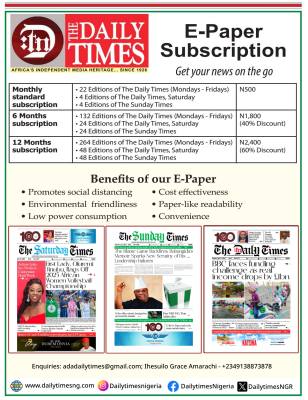Nigeria third most indebted nation in Africa with N187.8 trillion projected debt – Report

By Tunde Opalana
Nigeria has been ranked the third most indebted nation in Africa responsible for 8 per cent of Africa’s total external debt.
Nigeria trailed behind the second placed Egypt accounting for 13 per cent of the continent’s debt and South Africa which is the largest debtor with 14 per cent of Africa’s external debt.
The country alongside nine other African nations accounts for 69 per cent of the continent’s total external debt stock.
To complete the list of 10 most indebted nations in Africa are; Morocco and Mozambique each owing 6 per cent, while Angola 5 per cent. Kenya and Ghana 4 per cent each, and Côte d’Ivoire and Senegal 3 per cent each.
A new report, African Debt Outlook: A Ray of Optimism by the African Export-Import Bank (Afreximbank) revealed these.
Afreximbank estimates Africa’s total external debt stock at $1.16 trillion in 2023, with projections indicating an increase to $1.29 trillion by 2028.
READ ALSO: E-paper: 10 things you need to know on The DailytimesNGR
According to the report, Africa’s average cost of borrowing surged to 8.2 per cent in 2024, significantly higher than the stable 5.4–6.3 per cent range observed between 2008 and 2019.
The report hinged the debt burden on “external borrowing driven by underdeveloped financial markets, volatility in foreign exchange earnings, and the need for infrastructure financing”.
The Afreximbank report read, “In the first half of 2024, ten African nations constituted 69 percent of the continent’s total external debt stock, up from 67 percent in 2023. The countries leading this metric are South Africa (14 percent), Egypt (13 percent), Nigeria (8 percent), Morocco (6 percent), Mozambique (6 percent), Angola (5 percent), Kenya (4 percent), Ghana (4 percent), Côte d’Ivoire (3 percent), and Senegal (3 percent).”
X- raying Nigeria’s share of Africa’s external debt, the report indicated “reliance on international borrowing to finance budget deficits and critical infrastructure.
“The country has consistently accessed Eurobond markets, concessional loans from multilateral institutions, and other external financing options to bridge revenue gaps,” read the report.
It added that Nigeria remains a key player in international capital markets, issuing a $2.2 billion Eurobond in December 2024 to manage debt obligations.
The report highlights the increasing role of private creditors in Africa’s debt structure as multilateral institutions like the World Bank and IMF scale back lending.
“With private creditors offering higher-yield instruments, many African governments, including Nigeria, are turning to Eurobonds to finance fiscal shortfalls. While this approach provides immediate capital, it also carries risks, as commercial borrowing tends to come with higher interest rates and shorter maturities than concessional loans.”
The report classifies Nigeria’s debt risk as “moderate” alongside South Africa and Morocco. However, it warns of rising external borrowing costs amid tighter global financial conditions.
It said that with interest payments accounting for an increasing share of government revenue, Nigeria faces additional fiscal pressures.
“For Nigeria, improved fiscal management, economic diversification, and enhanced access to capital markets are expected to help stabilise its debt trajectory.
“Favourable macroeconomic conditions, stable interest rates, and improving credit ratings are cited as factors that could ease debt concerns across Africa.
“Global monetary easing is another factor shaping the outlook for debt. The U.S. Federal Reserve and other major central banks have begun reducing interest rates, a move expected to lower borrowing costs for African economies, including Nigeria,” the report added.
While Afreximbank presents an optimistic medium-term outlook, it also outlines risks that could undermine debt sustainability. Weak domestic revenue mobilisation remains a major challenge for Nigeria, given its dependence on oil revenues, which exposes the country to external shocks.
The country’s high fiscal deficits necessitate further borrowing, increasing exposure to global interest rate fluctuations. Currency depreciation remains another risk, as a weaker naira raises the cost of servicing external debt.
Afreximbank recommends that countries adopt stronger debt management strategies, including improving tax revenue collection, engaging with debt relief frameworks, and diversifying the economy by investing in manufacturing, agriculture, and renewable energy.
The report also calls for reforms in the global financial system to ensure fairer lending terms and better access to concessional financing for African economies.
The Daily Times recalled that in January this year, the International Monetary Fund (IMF) said that in 2025, Nigeria’s debt is projected to reach N187.8 trillion. This is due to rising borrowing costs.
Debt-to-GDP ratio :The IMF projects that Nigeria’s debt-to-GDP ratio will decline to 49.6% in 2025. A higher debt-to-GDP ratio can put pressure on a country’s finances. Debt servicing in 2025 is projected to exceed spending on health, education, security, and infrastructure combined.
It is worthy of note that the 2025 budget proposal had a deficit of N13 trillion, representing about 26.1% of the total budget.
The budget includes anticipated revenues from agencies such as the Federal Inland Revenue Service and the Nigerian Customs Service.
Debt sustainability
The global monetary body said debt sustainability depends on a country’s ability to manage its debt relative to its economic capacity.
Rising up to the occasion, the Federal Government planned to mitigate sustainability risks through enhanced revenue mobilization using tax reforms.








